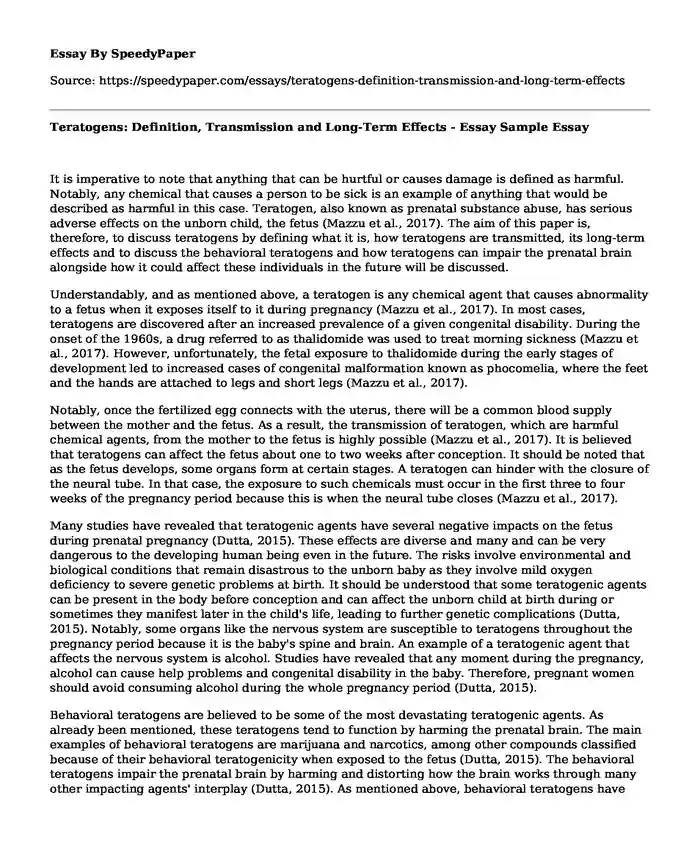
| Type of paper: | Essay |
| Categories: | Biology |
| Pages: | 3 |
| Wordcount: | 771 words |
It is imperative to note that anything that can be hurtful or causes damage is defined as harmful. Notably, any chemical that causes a person to be sick is an example of anything that would be described as harmful in this case. Teratogen, also known as prenatal substance abuse, has serious adverse effects on the unborn child, the fetus (Mazzu et al., 2017). The aim of this paper is, therefore, to discuss teratogens by defining what it is, how teratogens are transmitted, its long-term effects and to discuss the behavioral teratogens and how teratogens can impair the prenatal brain alongside how it could affect these individuals in the future will be discussed.
Understandably, and as mentioned above, a teratogen is any chemical agent that causes abnormality to a fetus when it exposes itself to it during pregnancy (Mazzu et al., 2017). In most cases, teratogens are discovered after an increased prevalence of a given congenital disability. During the onset of the 1960s, a drug referred to as thalidomide was used to treat morning sickness (Mazzu et al., 2017). However, unfortunately, the fetal exposure to thalidomide during the early stages of development led to increased cases of congenital malformation known as phocomelia, where the feet and the hands are attached to legs and short legs (Mazzu et al., 2017).
Notably, once the fertilized egg connects with the uterus, there will be a common blood supply between the mother and the fetus. As a result, the transmission of teratogen, which are harmful chemical agents, from the mother to the fetus is highly possible (Mazzu et al., 2017). It is believed that teratogens can affect the fetus about one to two weeks after conception. It should be noted that as the fetus develops, some organs form at certain stages. A teratogen can hinder with the closure of the neural tube. In that case, the exposure to such chemicals must occur in the first three to four weeks of the pregnancy period because this is when the neural tube closes (Mazzu et al., 2017).
Many studies have revealed that teratogenic agents have several negative impacts on the fetus during prenatal pregnancy (Dutta, 2015). These effects are diverse and many and can be very dangerous to the developing human being even in the future. The risks involve environmental and biological conditions that remain disastrous to the unborn baby as they involve mild oxygen deficiency to severe genetic problems at birth. It should be understood that some teratogenic agents can be present in the body before conception and can affect the unborn child at birth during or sometimes they manifest later in the child's life, leading to further genetic complications (Dutta, 2015). Notably, some organs like the nervous system are susceptible to teratogens throughout the pregnancy period because it is the baby's spine and brain. An example of a teratogenic agent that affects the nervous system is alcohol. Studies have revealed that any moment during the pregnancy, alcohol can cause help problems and congenital disability in the baby. Therefore, pregnant women should avoid consuming alcohol during the whole pregnancy period (Dutta, 2015).
Behavioral teratogens are believed to be some of the most devastating teratogenic agents. As already been mentioned, these teratogens tend to function by harming the prenatal brain. The main examples of behavioral teratogens are marijuana and narcotics, among other compounds classified because of their behavioral teratogenicity when exposed to the fetus (Dutta, 2015). The behavioral teratogens impair the prenatal brain by harming and distorting how the brain works through many other impacting agents' interplay (Dutta, 2015). As mentioned above, behavioral teratogens have serious side effects before and after the child's birth that advances to the later stages of the child’s development. These teratogens affect individuals in the future by affecting their emotional and intellectual reasonings (Dutta, 2015).
In conclusion, a comprehensive discussion has been made in this paper regarding the harmful effects of teratogens on a fetus. A teratogen definition has been elaborated alongside a discussion on how it is transmitted to the fetus from the pregnant mother. Further, long term effects of teratogens and behavioral teratogens have been discussed alongside indicating how it affects the prenatal brain and how it affects such individuals in the future.
References
Dutta, S. (2015). Human teratogens and their effects: a critical evaluation. International Journal of Information Research and Review, 2(03), 525-536. www.ijirr.com/sites/default/files/issues-pdf/0296.pdf
Mazzu-Nascimento, T., Melo, D. G., Morbioli, G. G., Carrilho, E., Vianna, F. S. L., Silva, A. A. D., & Schuler-Faccini, L. (2017). Teratogens: A public health issue–a Brazilian overview. Genetics and Molecular Biology, 40(2), 387-397. www.scielo.br/scielo.php?pid=S1415-47572017005014103&script=sci_arttext
Cite this page
Teratogens: Definition, Transmission and Long-Term Effects - Essay Sample. (2023, Nov 30). Retrieved from https://speedypaper.net/essays/teratogens-definition-transmission-and-long-term-effects
Request Removal
If you are the original author of this essay and no longer wish to have it published on the SpeedyPaper website, please click below to request its removal:
- Free Essay on the Educational Approach to Research
- Free Essay with a Book Review of "From the Milk River"
- Karl Marx thought about Capitalism, Free Essay Example
- Astrophysics Essay Sample
- Essay Sample on Artificial Intelligence Future and It Perils
- Free Essay Example on Uses of Charcoal
- Free Essay - the Rio Grande River
Popular categories




